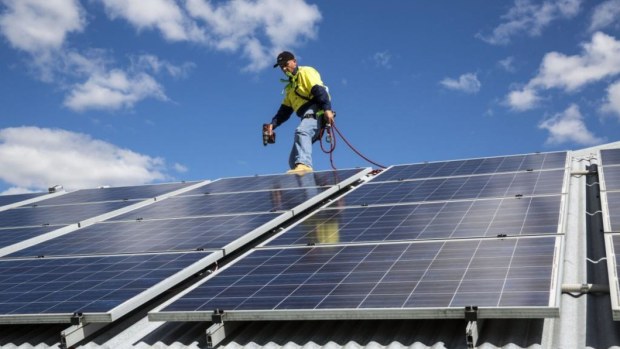SA solar overload sparks huge power discounts

South Australia's flood of rooftop solar installations could lead to households being offered discounts of as much as 75 per cent on electricity prices during the middle of the day.
The innovative "time of use" tariffs are being offered by start-up IO Energy, and it expects these to lure customers away from the big power companies.

One in three households in South Australia has rooftop solar panels. Glenn Hunt
The strategy of IO Energy, based in Adelaide's Lot Fourteen innovation hub, is to capitalise on the unprecedented wave of solar power that is affecting South Australia's grid and causing spot market prices to slump between about 10am and 3pm.
It will also take advantage of the "solar sponge" network tariff introduced by distributor SA Power Networks (SAPN). This offers tariffs as low as 25 per cent of the flat rate during peak solar hours as it seeks to shift demand into those lean periods to prevent the load from dipping so low that it destabilises the grid.
"We’re trying to capitalise on that and allow regular consumers to benefit from solar coming into the grid, lowering their carbon footprint and lowering their bills, and also alleviate some of those issues that are arising in that low voltage distribution grid," IO Energy chief executive Rob Morris said.
He said substantial savings would be available for customers who were able to shift their usage into the middle of the day, or who could add a battery to soak up and save cheap power during the solar peak.
SAPN introduced its "solar sponge" tariff on July 1 to combat the high levels of generation from rooftop solar panels in its low-voltage network. It allows households with smart meters to access a "super" off-peak tariff of about a quarter of the standard rate between 10am and 3pm when the power being pumped out by rooftop panels is so high that it can exceed demand in parts of the local grid.
‘Solar sponge’ rates
IO estimates that a new customer on its "solar sponge" rates will get prices about 75 per cent lower than typical flat rates and 50 per cent lower than "time of use" rates offered by other retailers that reflect the fall in the SAPN network tariffs but not the lower wholesale costs.
However, customers on the full-blown "time of use" plan will also pay an extra charge during the evening peak-demand period, meaning it is suitable only for those who can shift the bulk of their usage – whether pool pumps, batteries, electric vehicles or dishwashers and other appliances – to the part of the day when it's cheaper.
Mr Morris also expects the home battery market to be supercharged by IO's retail offers as households are incentivised to add storage to access the midday tariffs.
Access to dynamic retail pricing that changes during the day is, however, limited to customers with a smart meter, which is about 20 per cent of South Australian households at present, although the number is growing as meters are replaced.
The issues arising with the sharp rise in rooftop solar generation in South Australia have been a concern for the Australian Energy Market Operator, which is moving to take more control of the system by securing the power to cut off rooftop panels if necessary during rare situations when the grid needs to be kept secure.
AEMO said in a report last month that to its knowledge, South Australia was the first gigawatt-scale power system in the world to approach zero operational demand during the day, because of high generation from distributed resources such as rooftop solar.
Australian Energy Regulator chair Clare Savage said in a recent interview that tariff reforms were a critical part of the plan to manage the growing issue of minimum demand on parts of the grid, which is why the regulator had approved of the SAPN "solar sponge" tariff.
The still-growing popularity of rooftop solar – one in every three households in the state has panels – meant the hollowing out of daytime wholesale prices – often into negative territory – was happening faster than predicted, Mr Morris noted.
IO Energy, which will team up with a licensed electricity retailer to launch its offers on August 1, expects to lure customers away from the main providers. The top six hold a dominant 95 per cent of South Australia's household market.
Subscribe to gift this article
Gift 5 articles to anyone you choose each month when you subscribe.
Subscribe nowAlready a subscriber?
Introducing your Newsfeed
Follow the topics, people and companies that matter to you.
Find out moreRead More
Latest In Energy
Fetching latest articles